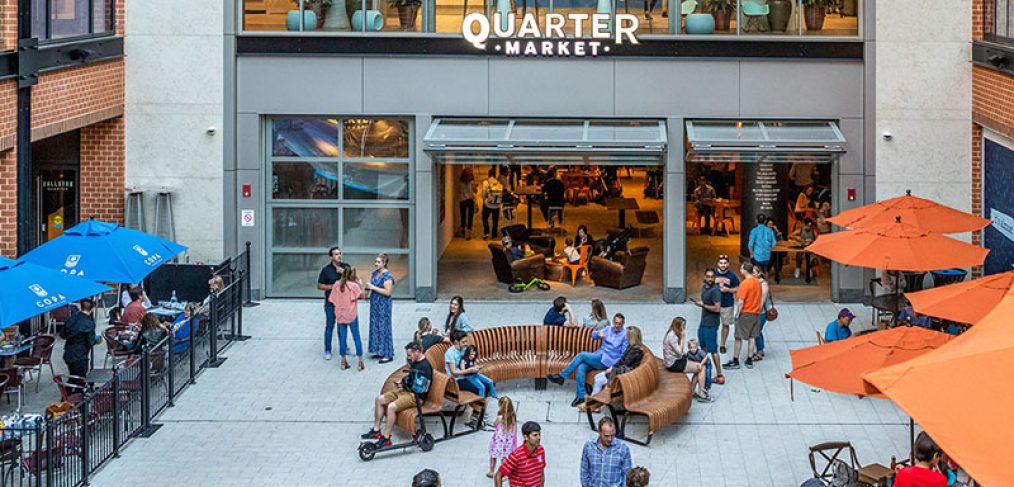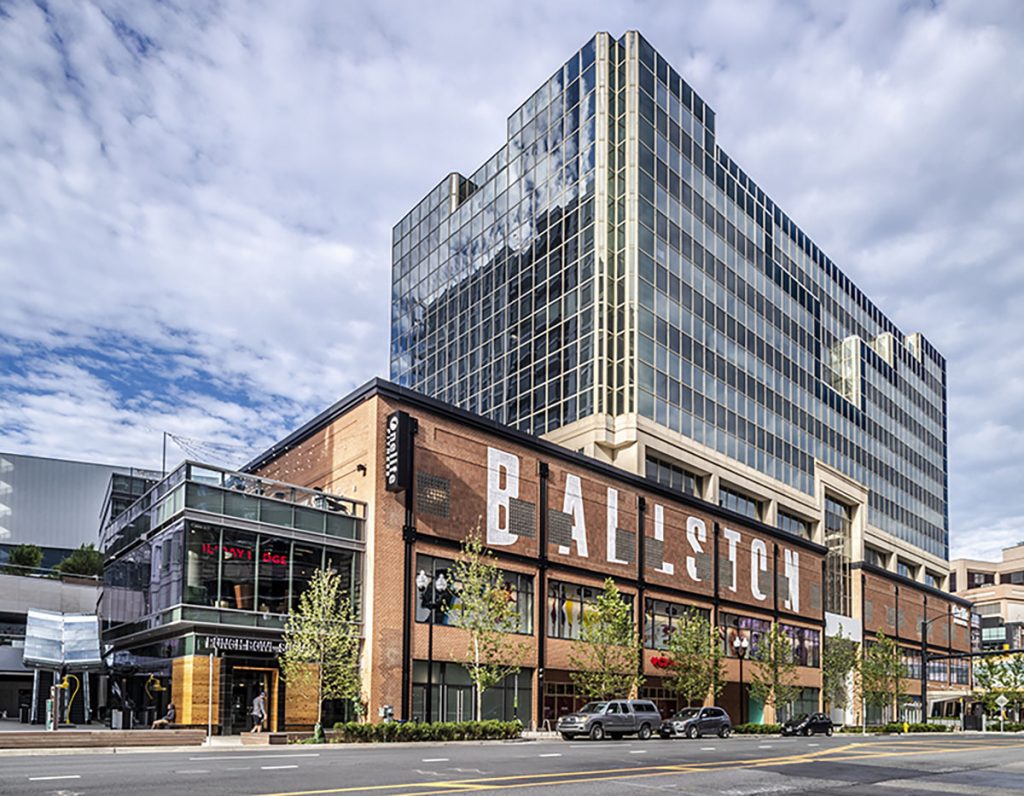
Retail Re-invention: Five Questions to Ask
It is a truth universally acknowledged, even to those of us who make a living designing them, that the traditional enclosed shopping center has courted better prospects. The conventional dumb-bell mall is a development model that has cried out for re-invention for at least the last decade (some would claim longer), and the need for fresh ideas likely passed long ago. The future doesn’t look good.
And yet these lumbering dinosaurs still roam the earth, attracting the attention of an entire industry hellbent on extending their survival, finding solutions to seemingly intractable challenges, and settling on an answer to the immortal question: Should we charge for parking?
Why have some malls survived their long-predicted demise, thriving and bumping with new generations of shoppers, while others have been relegated to the ash heap of deadmalls.com? Well, a lot of it has to do with location…and the ability to predict (or at least adapt to) an uncertain future. But, before we go there, a bit of context:
In the last decade—which is another way of saying, during the rise of Amazon—the quaint idea of going to a store to buy something has all but evaporated. Sure, way back in the early naughts there were catalogs and toll-free numbers with a chirpy voice on the other end but, essentially, brick and mortar stores had a lock on the transaction. That’s no longer the case.
Online shopping’s greater ease, convenience and (many would argue) value, is the tailwind that has propelled e-commerce into capturing more and more dollars, which many expect to reach 30-40% of retail spending in the not-to-distant future. That is, if any stores other than Amazon still exist. According to real estate research firm CoStar Group, as of mid-November, retailers have announced plans to close more than 10,600 stores nationwide; which compares with 5,400 for all of 2018. The result is developers and retailers face persistently negative mall traffic and will need to fight a righteous fight to bring back the glory days.

Ballston Quarter in Arlington, VA © CallisonRTKL
Reinventing the Wheel: Is it worth it?
While it’s difficult to argue with the facts, or the gut-wrenching sight of boarded-up shop fronts, many developers are still uncertain when it comes to the urgency for reinvention, let alone a more robust effort to add complementary uses (residential, hospitality, etc.) or complexity. To be sure, that level of change is no small undertaking and typically comes with a big frosty mug of risk and exposure. So why do it?
The easy answer is to say that the back-end return is hard to ignore. The more complicated answer is that it is the responsible thing to do. It responds to economic forces and demographic shifts. It strengthens neighborhoods and enriches communities. And it repurposes real estate in a way that improves most aspects of civic life.
Take the reinvention of Ballston Common in Arlington, VA, across the Potomac River from Washington, DC, into the recently opened Ballston Quarter. The area’s existing condition gradually shifted from what could only be called “quintessential edge city generic” to a thriving, moderately priced community for the area’s growing population of young, tech-savvy consumers. The 30-year old mall had to change. Or die.
As the design architects, CallisonRTKL removed about two-thirds of the mall roof, creating an open-air, two-level street anchored by an existing Macy’s at one end and replacing a Macy’s Home Store with a new 400-unit, 26-story luxury residential tower over new retail at the other. We converted the upper level in a OneLife Fitness Center on one side, with a three-level Punch Bowl Social taking the remaining third-level space, leaving a two-level “street” leased to multiple tenants below.
The result is not only a de-malling but a complete reinvention of the model into a dense, street-focused urban district that responds to the demographics, showcases new types of retailers and a new appetite for food as a building block of community.
So, when do you know it’s time to take the plunge of reinvention? Here are five questions to ask:
- Is the center more about the transaction rather than the experience?
For all the reasons mentioned above, malls have to offer something more than just shopping and, these days, that means thinking outside the food court and multi-plex, though those are still important. Dining (which suggests a civilized activity that lasts longer than five minutes and done while sitting down) is certainly the easiest and most obvious way to boost the experience quotient, but even this has begun to run its course and fall into tired tropes of the same ol’ same ol’. Today’s F&B needs to be more about the fuller experience—good food fast outsells fast food all the time. The trends that are reshaping the restaurant industry (farm to fork, name chefs, healthy eating) have begun to make their way into a mall near you.
Beyond this, tomorrow’s retail centers will be programmed with events that can attract various audiences across different times of the day and season, and this takes the operational chops and the right type of spaces to succeed. The ratio of public to leasable space, currently in the 80/20 range will likely need to move closer to a 50/50 split. This may seem self-evident, but it means that developers need to shift their thinking from tenancies to something more fluid, dynamic and topical. If the mall cannot accommodate a variety of gatherings, pop-ups or non-retail events, the format needs to change.
- Are we high on the generic meter?
While it’s easy to reduce reinvention to an aesthetic discussion, the idea speaks directly to relevance and the absolute requirement to find some degree of differentiation and meaning within your market. Ballston Quarter happened because the growing market there cried out for something new, especially when it came to retail and dining options. Any experienced shopper can pretty much name the roster of retailers in any mall—the usual suspects—and that contributes to the homogeneity so endemic to the model. A mall in Dallas differs very little from a mall in a Chicago or a Los Angeles suburb. Well, why should it? Because each of these areas has wildly different demographics, cultural and social norms, not to mention weather patterns.
Striking the right tenant mix is critical and a fundamental tenet of Malls 101. But if the retail apocalypse has taught us nothing else, it is that malls also need to be custom-curated for a local market. Smart consumers, who no longer tolerate the sameness, seek unique, usually hyper-local, retailers or experiences.
This means that leasing and tenanting strategies need to change and become much less risk-averse than they are currently. Smaller, more provincial retailers are notoriously difficult to deal with—and often require some type of handholding or subsidy—but they are an effective way of chipping away at the homogeneity and creating the special sauce needed to stand out.
At a very basic level, the store depths of a few years ago are no longer valid in today’s market, meaning the standard lease envelope needs to adjust to something more flexible, smaller and dynamic.
- Is your mall leveraging technology?
It took a while, but we are finally at the point where technology is defined not by giant monitors hanging off bulkheads but, rather, as an enabler that allows retailers and developers to have deeper, more meaningful conversations with their constituents. Smart tech, and the abundant data and analytics that accompany it, is an essential component of tomorrow’s commercial development.
Back in 2014, though it remains relevant today, the good people at McKinsey identified three ways technology can transform a mall experience:
- By extending the relationship with the customer before and after the mall visit. How many malls have Instagram moments, a content-strategy or even a social media road map?
- By transforming “pain points” into “delight points.” For example, tech that makes parking spaces easier to find, locates product inventory (Where can I find a red cashmere sweater?) or works to make us safer.
- By elevating the shopping experience from the transactional to the transformational. Says McKinsey: “It is critical for malls to take a more active role in shaping the shopping experience, either by acting more like retailers or by partnering with them. Mall players are experimenting with a variety of different business models to make this happen, but there are no certain winners yet.”
And so we wait.
This is not to say that these types of initiatives aren’t happening…they just aren’t happening fast enough. A few retailers are genuinely trying to change the calculus, and some of these have begun to chip away at the status quo. B8ta, for example, is a relatively new tech retailer that gives shoppers a hands-on opportunity to try out an array of gizmos and products in-store before buying them. Nothing too revolutionary about that these days, but, unlike other retailers, the company sees none of the profits. Instead, its revenue model is based on leasing space to product makers on a month-to-month basis. Also, data informs every decision, with inventory continually changing, based on a product’s past performance and user interest. Those insights then get shared with product makers, who use the information to evaluate their marketing efforts and improve R&D.
- Are you competing against non-competitors?
Time was that it was problematic to have more than one or two malls within a 50-mile catchment area, and this was largely the consequence of retailers not wanting to cannibalize their own customer base or the challenges posed by nearby competition. Since the transaction can now happen anywhere, malls are finding themselves competing against other developments that may not necessarily be retail-driven.
Time has become our most precious commodity, and the thing that made malls popular in the first place (convenience) is no longer the prime motivator That is, malls are no longer competing for wallet share; they are competing for watch share.
Today’s most potent commercial developments almost all rely on residential as their engine—a significant shift from a decade ago—and focus their energy on fostering a sense of community and neighborhood above a place to buy stuff. Crossing categories—another way of looking at mixed-use—creates a more flexible (albeit complex) model that bakes in many of the ideas mentioned here.
- Am I a platform for emerging retailers?
As we’ve said, today’s retailers rely less on brick and mortar for the transaction than they do for showcasing the brand, fostering loyalty or extending the experience. Even the best online retailers eventually come to understand they have to meet their customers face-to-face (IRL), for whatever reason. Consider Bonobos and Warby Parker. Both of these “digital native” retailers focus on a specific and curated merchandise mix (or service) that just don’t need as much space as traditional retailers.
Another great example is Glossier, which blurs the line between an online influencer and a cult-favorite retailer. Still relatively new to the brick-and-mortar world, Glossier stores are perfect fodder for Instagram and Snapchat (which the retailer routinely mines, so its data analytics tools can measure how popular each product is on social media. The brand then adjusts its product lines accordingly). Glossier also partners with places like Morgenstern’s Ice Cream and Momofuku in Manhattan as well as Rhea’s Café in San Francisco to host pop-up events. It’s a move that keeps people coming back, both online and in-store.
The lesson here is simple: shoppers are looking for an experience; give it to them.
Malls as a development vehicle are not going away, but the ones who have survived and thrived have figured out one thing: they must adapt. They must change…because retail is changing, consumers are changing and, well, the world is changing. The path to survival is not to react to that change but to embrace it.
